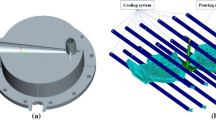Abstract
During the production of thin shell plastic parts by injection molding, warpage depending on the process conditions is often encountered. In this study, efficient minimization of warpage on thin shell plastic parts by integrating finite element (FE) analysis, statistical design of experiment method, response surface methodology (RSM), and genetic algorithm (GA) is investigated. A bus ceiling lamp base is considered as a thin shell plastic part example. To achieve the minimum warpage, optimum process condition parameters are determined. Mold temperature, melt temperature, packing pressure, packing time, and cooling time are considered as process condition parameters. FE analyses are conducted for a combination of process parameters organized using statistical three-level full factorial experimental design. The most important process parameters influencing warpage are determined using FE analysis results based on analysis of variance (ANOVA) method. A predictive response surface model for warpage data is created using RSM. The response surface (RS) model is interfaced with an effective GA to find the optimum process parameter values.
Similar content being viewed by others
References
Yuanxian GU, Haimei LI, Changyo S (2001) Numerical simulation of thermally induced stress and warpage in injection-molded thermoplastics. Adv Polym Technol 20(2):14–21
Lui SJ (1995) Modeling and simulation of thermally induced stress and warpage in injection molded thermoplastics. Polym Eng Sci 35:1511–1517
Bushko WC, Stokes VK (1995) Solidification of thermoviscoelastic melts, part II: effect of processing conditions on shrinkage and residual stress. Polym Eng Sci 35:365–370
Jacques MST (1982) Analysis of thermal warpage in injection molded flat parts due to unbalanced cooling. Polym Eng Sci 22:241–245
Matsuoka T, Takabatake J, Koiwai A, Inoue Y, Yamamoto S, Takahashi H (1991) Integrated simulation to predict warpage of injection molded parts. Polym Eng Sci 31:1043–1049
Huang MC, Tai CC (2001) The effective factors in the warpage problem of an injection-molded part with a thin shell feature. J Mater Process Technol 110:1–9
Lee BH, Kim BH (1995) Optimization of part wall thicknesses to reduce warpage of injection-molded parts based on the modified complex method. Polym Plast Technol Eng 34(5):793–811
MoldFlow Corporation (2001) MoldFlow Plastic Insight 3.0. Moldflow Corporation, Wayland, MA
Myers RH, Montgomery DC (1995) Response surface methodology process and product optimization using designed experiments. Wiley, New York
David G (1989) Genetic algorithms in search, optimization and machine learning. Addison-Wesley, Boston
Author information
Authors and Affiliations
Corresponding author
Rights and permissions
About this article
Cite this article
Kurtaran, H., Erzurumlu, T. Efficient warpage optimization of thin shell plastic parts using response surface methodology and genetic algorithm. Int J Adv Manuf Technol 27, 468–472 (2006). https://doi.org/10.1007/s00170-004-2321-2
Received:
Accepted:
Published:
Issue Date:
DOI: https://doi.org/10.1007/s00170-004-2321-2




